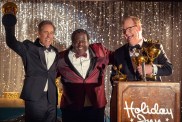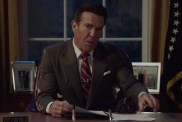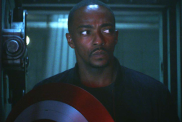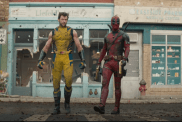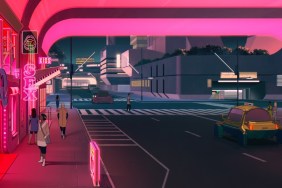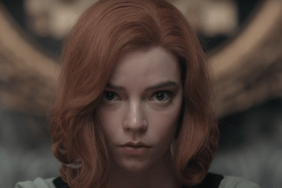When The Hunger Games finally arrives in theaters this Friday, it’s a good bet that fans of Suzanne Collins’ novel trilogy will thrill to the sight of Jennifer Lawrence’s take on Katniss Everdeen, delight at the adaptation’s take on her romantic triangle and be kept on the edge of their seat by the gripping, deadly competition that is the Capitol’s deadly tournament.
What the same fans may not be expecting, however, is the subtle technical mastery of writer/director Gary Ross, who, with just two previous directorial efforts under his belt (Pleasantville and Seabiscuit), steps up to the plate of the blockbuster and makes a decided impression as a cinematic auteur.
“[W]e never broke frame and let you think of this as a glossy piece of entertainment,” Ross tells ComingSoon.net in the following interview, wherein he discusses the finer details of capturing Collins’ world and talks about what rules — be they jump cuts or other non-traditional edits — needed to be broken to bring The Hunger Games to life.
CS: One of the first things that struck me about the look of “The Hunger Games” is how you break the 180 degree rule in a very stylistic manner. That’s not an easy thing to pull off and it achieves a very distinct look in the final film. Can you talk about why you chose to take that approach?
Gary Ross: Thank you! You know, both my editors, Juliette Welfling and Stephen Mirrione, are tremendously comfortable with that. We also cut from people to the same people. There are like 300 jump cuts in the movie, too. You’re not supposed to cut from a person to themselves. We break a lot of rules, but it’s all very, very conscious and all within a style that we talked about in advance. It keeps the pace of the movie going and keeps the movie a little bit destabilized, as Katniss is. I love jumping the axis. I think that’s an absolute blast. But you have to do it in a way where you still maintain geography. It’s very astute of you to notice. We do that a lot, but it’s all very well thought-out.
CS: I liked the idea that, if the Hunger Games were real, that’s how you’d shoot them out of necessity. Then it’s sort of expanded to the whole film.
Ross: Yes! Also, it doesn’t put you into a boring or predictable movie rhythm. It puts you into a little bit of Katniss’ head thinking, “Where am I? What’s around me?” It’s a very necessary component of the style.
CS: And the notion of “The world will be watching.”
Ross: Oh, absolutely. Very much so.
CS: Another connection I wanted to ask about is that of television in your films. “Pleasantville” and “Seabiscuit” are also both very much about the world connecting through the medium.
Ross: That’s really interesting that those are media-centric events and so is this. “Seabiscuit” does become a pop phenomenon in a lot of ways that media is exploited and played. And “Dave,” too, in a certain extent embraces that phenomenon of this guy and how he’s exploited. That’s very interesting. I hadn’t thought about it, but I certainly do see a through-line.

CS: One of the fascinating aspects of the games themselves is that the film takes place in a world where, to us, this is a monstrous thing, but once we accept that it’s fiction, we’re just as excited to witness them as an audience.
Ross: I think that one of the brilliant things in the premise and in the book is that there is a lurid fascination, like watching auto accidents. One feels kind of morbidly compelled to watch. That’s the power of the games themselves and the games are used as an instrument of political control to get people to kind of complicitly participate. I think that one of the things that Jenn [Lawrence] realizes is, “I’m going to refuse to play this game.” Her act of defiance comes from her own sense of personal morality, her own personal ethics and the way that those have evolved. I think that that’s really, really interesting in the piece itself.
CS: There’s something about the film that recalls classic science fiction cinema. The production design side of the visual reminded me a lot of the film version of “Fahrenheit 451,” but it”s balanced with a very modern handheld style.
Ross: Well, I’m a very big fan of Francois Truffaut. I think “400 Blows” probably has a lot of handheld cameras in it, too. But, yes, there’s a very verité quality to this. I think what you’re saying when we talk about “Fahrenheit 451” is that the science fiction feels very real. It feels completely rooted. We don’t indulge the futuristic society. We’re using it to investigate something that relates to our culture and to our world. I wanted it to always feel completely rooted and real. That drove a lot of the aesthetic decisions in the movie. I never wanted you to feel like you were in a movie. I wanted you to feel like you were there.
CS: There is CGI, but its very confined.
Ross: Yeah. There’s a ton of CG that you probably don’t notice. When you’re in the Seam, where she lives, a lot of the mines and other backgrounds are created in a computer. In the chariot sequence, literally all we had was a road. That entire city and all that stuff is created in a computer. We had real crowds that we then cloned or tiled. I don’t really believe in using digital people. But all the buildings and everything that you see is created. But my feeling about CG is that it’s like music. You shouldn’t notice it. It should support the film. So we worked very, very hard in creating CG that you don’t notice.
CS: Speaking of music and to that same point, it’s a very subtle score.
Ross: I want you to lean forward into the frame. I don’t want to push you back. I don’t want you to passively receive the movie. I want you to engage in the movie. The score needs to be kind of transparent enough that you can engage what’s going on on the screen. I don’t want to be bombastic and hammer you with a, quote, “movie moment.” Then you feel, “I’m in a movie,” and you get an aesthetic separation from that and the intensity of the movie. My job is to pull you in and make this feel completely real all the time and never break the frame. If I was to hammer away with a repetitive orchestral theme or something like that, it would say to you that you’re in a movie. I don’t want you to feel like you’re in a movie. I want you to feel like you’re in the games.

CS: Even in the world of the film, the sound of the Mockingjay ends up being such a powerful, distinct and yet very simple piece of audio.
Ross: That’s all Lon Bender, who’s my sound designer. He was just nominated this year for “Drive” and won an Oscar for “Braveheart.” He’s one of the best sound designers in the world. In fact, I gave him a main title credit because it was so special what his work was on the film. Lon did unbelievable work. The sound of those Mockingjays and the way that they pick up the melody, they really feel like birds. The way that they echo. It’s also my mixers, Mike Prestwood Smith and Mike Keller, are so absolutely critical to maintaining the subjectivity of this. There are so many times where you just hear things the way Katniss hears them. A great example is when she goes up in the tube and the door shuts. We pulled all the room tone out. There’s literally a moment on the track where it’s just blank mag at that moment. It’s just literally dead. We create a lot of subjectivity. Either you or one of your friends commented to me that, at the cornucopia melee, you don’t hear anything. It’s just music and we pulled all the sound out. A lot of that is to just maintain the subjectivity.
CS: A lot of your cast has talked about how you direct and the very specific details you focus on. They say that you just seem to instinctively know what colors should be used to tell a story and that you approach a scene from the tiniest elements. Is there an element of directing that weren’t sure of going in or something that specifically wanted to strengthen in the making of this first chapter?
Ross: I knew that I needed to police the tone of the movie. I knew I needed to maintain what was a very narrow bullseye, tonally. That goes with all the stuff you’re talking about. The use of the verité. How we kept things real. How we kept you engaged. That we never broke frame and let you think of this as a glossy piece of entertainment. Tonally, that this thing never become an unreal world, because then you’re out of Katniss’ point of view and the whole thing falls apart. That’s all I was thinking about, really. I was just thinking about tone, tone, tone and how it was a much more narrow target than I’ve had on any other movie. “Pleasantville” seems tonally ambitious, but it can handle a wide breadth of tone because it’s so fanciful. In this one, the tone just had to be just very, very specific and, because of the seriousness of the plot, had to be really deftly handled.
The Hunger Games arrives in theaters this Friday, March 23rd.

